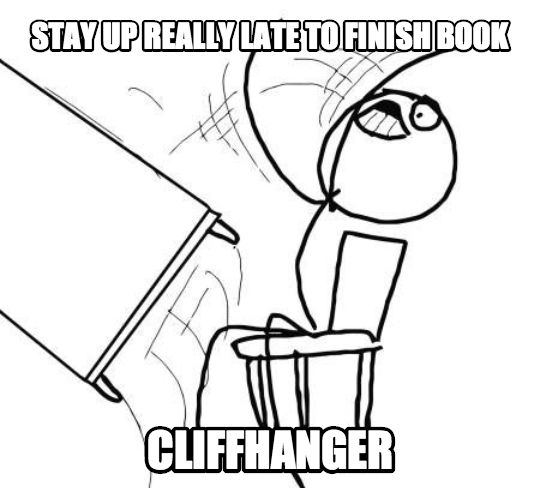It is an undeniable truth: a reader’s emotions are at the mercy of the author.
And a cliffhanger is a pretty infallible way to pull strong emotional reactions from readers. We’ve all run into a cliffhanger: an abrupt ending or a thrilling plot twist during a moment of elevated drama, introduced to maintain suspense.
Cliffhanger-induced emotions range from elated anticipation for the next installment of the story, to pleasant introspection on subtext, frustration for the prolonged suffering of a character, and even blind rage at a cruelly timed cutoff.
Any of the above reactions could be part of a writer’s devious plan to entertain readers. It’s a strong literary device when well written. But unless it serves some vital purpose, anger should not be the emotional goal for writers.
Endings, regardless of closure, often stay foremost on our minds when recalling a finished book, so it’s important to leave readers with a good impression. Cliffhangers need to be employed wisely and craftily.
Done well, cliffhangers are a great strategy to keep readers engaged, quickly turning to the start of a new chapter. They’re also a strong marketing tactic, driving readers to purchase the next installment of a series. A great cliffhanger leaves the reader excited, anxious, even desperately craving, to know what happens next. Most of the time, it works in the author’s favor, like those on this list.
Done poorly, it leaves readers unfulfilled and with too many unanswered questions: Did the author intend to do that? Did I miss something? Am I supposed to draw my own conclusions? Why would that character do such thing? Or—most commonly asked, especially after chucking said book with bad cliffhanger at the nearest wall—that’s it? Why would this author play so callously with my emotions this way?
For a book ending on a cliffhanger, yes, it does play with readers’ emotions in the last few pages. That’s simply the nature of the beast. However, it also needs to respect the first 300-or-so pages that have built up to this thrilling ending. Why follow the characters through all the ups and downs, page after page when we don’t receive a reward?
Readers don’t appreciate feeling frustrated and dissatisfied. They want to know all the work they’ve put into reading your book was worthwhile.
A cliffhanger employed in a series can be appropriately timed and reveal just enough new information to tease the next book, while still tying up each individual installment. The key is to thoroughly strategize an overarching plot line to connect all of the books, while developing a self-contained plot in each installment. That way, you leave the reader with enough answers to have a [mostly] complete and satisfactory ending with each book.
Using cliffhangers at the end of a chapter is also a stellar technique—they are page-turners. Ending the chapter by sending your character to bed is fine if it the closing of the scene calls for it—but let’s face it, it doesn’t drive your reader to the next chapter.
Cliffhangers lead readers to the next chapter and call up that infamous internal promise to read “just one more chapter” before they go to bed. Chapter cliffhangers need to be used sparingly, though. Consistent abrupt endings only leave readers exhausted; readers still feel smaller cycles of anticipation and closure throughout the novel.
Bottom line: writers need to ask themselves if their story is being fair to their readers.
Sloppy writing, easy outs, vague story endings, and cheap selling tactics do not make the cut or readers’ approval. Be sure to tie up as many loose ends as possible and give readers some sense of fulfillment and closure. Otherwise you risk losing your readership.
How do you define a good cliffhanger? Read any lately that left you happy or frustrated?
And next Monday, check back in, because we’re going to be doing how-to for chapter cliffhangers … see what we did there?


Thank you both, No Blank Pages and Yesenia Vargas, for sharing this post! We appreciate it!